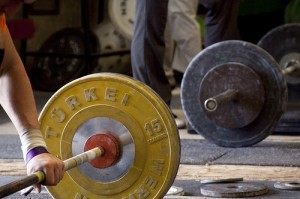The New Workout
A couple of posts ago I outlined my new strength program which I adapted from a Mike Mahler program. I stayed with those exercises for six weeks. Now I’m rotating most of those exercises out for new exercises that are as Pavel Tsatsouline says, the “same but different.” This means that the new exercises should look like and require similar movement patterns as the previous exercises. Here are my changes:
[table "1" not found /]
I’m still doing barbell cleans but now each week I’m either doing cleans 2x/week and barbell snatches 1x/week or vice versa. I’m trying to learn to snatch the barbell and I’m pretty new to it. I’m still doing Renegade Rows and I’m trying to find time to do Turkish Get-ups 2x/week instead of just once. The TGU is very difficult so I figure I need to work on it more. (If you’re not good at something, you don’t like doing it and it’s real hard–then you should probably do a lot of it.) Similarly, I’m keeping the kettlebell windmills.
I plan to stay with this new scheme for four weeks and change it up again. I’ve also added weighted 45 degree back extensions 1x/week. I believe this plus the good morning will help my deadlift and squat numbers go up.
Why have I rotated the exercises? I’ll let powerlifting expert Louie Simmons of the Westside Barbell Club explain:
“Science has proven that training at a 90% or above for 3 weeks will cause physical and mental fatigue. With the Westside conjugate method we switch a core barbell exercise each week to avoid accommodation. “
Further, from a mental viewpoint, changing exercises keeps things interesting. I like doing new things. There are a ton of useful exercises out there. By cycling the exercises I get to stimulate the mind.
(BTW, Louie also says they at Westside “live on the good morning.” Seems that it’s essential for improving the squat and deadlift. Thus I’ll likely do some version of it for a long time to come.)
My sets & reps scheme is a variation on the Windler 5-3-1 protocol. It looks like this:
Week 1: 3 sets x 5 reps. I work up to a 5RM and do three sets
Week 2: 3 sets x 3 reps done in similar to the 3×5
Week 3: 5 reps – 3 reps – 1 rep
Week 4: Back off. I may skip lifting altogether or do something alone the lines of 1×10 reps at 50% of my 1 RM. The point is to take it easy and RECOVER.
Westside Barbell Squat & Deadlift Manual
Speaking of Louie Simmons and Westside, I recently got the Westside Barbell Squat & Deadlift Manual. There’s a wealth of fantastic info in there from literally the strongest group of people on the planet. (I look forward to reading the Westside Barbell Book of Methods and the Bench Press Manual as well.)
Most interestingly, I learned that those guys change their main exercises every week–but they very rarely do the standard issue competition powerlifts: the squat, bench press, and deadlift. They do variations on those exercises: box squats, board bench presses, good mornings and a billion other variations on the competition lifts. They use bands and chains to vary the nature of the resistance on the bar. Different bars are used and different speeds are used when lifting. Why? It goes to the concept Louie mentioned up above. All these variables are changed in order to prevent accommodation. If you’ve accommodated to the exercise then you’ve essentially gotten used to it and progress will slow.


